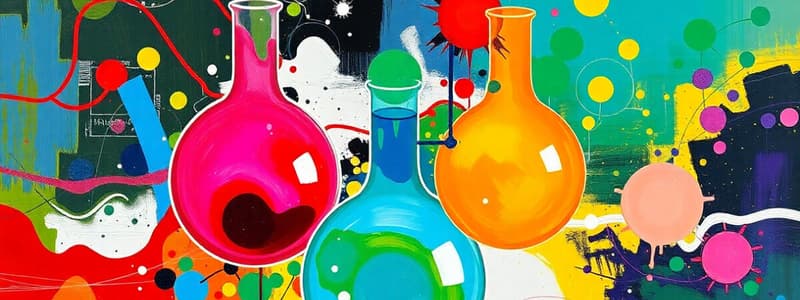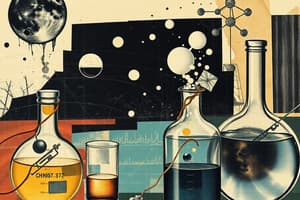Podcast
Questions and Answers
What is the difference between a physical property and a chemical property?
What is the difference between a physical property and a chemical property?
- A physical property is related to the appearance of a substance, while a chemical property is related to its reactivity with other substances.
- A physical property can be observed or measured without changing the composition of the material, while a chemical property describes how a substance can be converted into another.
- A physical property is a characteristic of a substance that can be observed without changing its chemical composition, while a chemical property describes the substance's ability to change into a new substance. (correct)
- A physical property can be changed by altering the temperature, while a chemical property is unchanged by temperature.
Which of the following is NOT an example of a physical change?
Which of the following is NOT an example of a physical change?
- Salt dissolving in water
- Burning wood (correct)
- Iron rusting
- Water freezing into ice
Which of the following statements about pure substances and mixtures is true?
Which of the following statements about pure substances and mixtures is true?
- A pure substance is composed of more than one substance, while a mixture is composed of a single component.
- A pure substance can be broken down into simpler substances by physical changes, while a mixture cannot.
- A pure substance has a constant composition, while a mixture can have a varying composition. (correct)
- A pure substance can be separated into its components by a physical change, while a mixture cannot.
What is the difference between an element and a compound?
What is the difference between an element and a compound?
What is the mass number of an atom?
What is the mass number of an atom?
How many significant figures are in the number 0.00245?
How many significant figures are in the number 0.00245?
What is scientific notation used for?
What is scientific notation used for?
Which of the following is an example of a diatomic element?
Which of the following is an example of a diatomic element?
What is the relationship between the atomic number and the number of protons in an atom?
What is the relationship between the atomic number and the number of protons in an atom?
What are valence electrons?
What are valence electrons?
Which of the following is NOT a property of metals?
Which of the following is NOT a property of metals?
What are isotopes?
What are isotopes?
Which group on the periodic table contains the noble gases?
Which group on the periodic table contains the noble gases?
What is density?
What is density?
How does specific gravity differ from density?
How does specific gravity differ from density?
What is the correct formula for converting degrees Celsius to degrees Fahrenheit?
What is the correct formula for converting degrees Celsius to degrees Fahrenheit?
Flashcards
Three states of matter
Three states of matter
Solid, liquid, and gas are the forms matter can take.
Solid
Solid
Has a definite volume and shape; particles are closely packed.
Liquid
Liquid
Has a definite volume but takes the shape of its container; particles can slide past each other.
Gas
Gas
Signup and view all the flashcards
Physical properties
Physical properties
Signup and view all the flashcards
Chemical change
Chemical change
Signup and view all the flashcards
Pure substance
Pure substance
Signup and view all the flashcards
Mixture
Mixture
Signup and view all the flashcards
Atom
Atom
Signup and view all the flashcards
Mass number
Mass number
Signup and view all the flashcards
Protons
Protons
Signup and view all the flashcards
Electrons
Electrons
Signup and view all the flashcards
Density
Density
Signup and view all the flashcards
Significant Figures
Significant Figures
Signup and view all the flashcards
Isotope
Isotope
Signup and view all the flashcards
Study Notes
States of Matter
- Solids have a definite volume and shape, their particles are tightly packed in a regular three-dimensional array.
- Liquids have a definite volume but take the shape of their container, their particles are close together and can move around.
- Gases have no definite volume or shape, they fill the entire container they are in, their particles are far apart and move randomly.
Physical/Chemical Properties and Changes
- Physical properties can be observed or measured without changing the composition of the substance (e.g., boiling point, melting point, color, odor).
- Physical changes alter the substance's appearance but not its chemical composition (e.g., melting ice, boiling water).
- Chemical properties describe how a substance can be converted into another substance (e.g., flammability, reactivity with acids).
- Chemical changes/reactions convert one substance into another, usually not reversible (e.g., burning paper, metabolizing food).
Pure Substances and Mixtures
- Pure substances consist of only one component, with a constant composition regardless of sample size or origin (e.g., water, table sugar).
- Mixtures contain more than one substance, with a composition that can vary (e.g., a mixture of sand and water).
Elements and Compounds
- Elements are pure substances that cannot be broken down into simpler substances by chemical means.
- Compounds are pure substances formed by chemically combining two or more elements.
Matter
- Matter is anything that has mass and takes up space.
Chemistry
- Chemistry is the study of matter, its composition, properties, and transformations.
Significant Figures
- All nonzero digits are significant.
- Zeros between nonzero digits are significant.
- Zeros at the end of a number with a decimal point are significant.
- Zeros at the beginning of a number are not significant.
- The significant figures in a calculation depend on the number with the fewest significant figures in the calculation.
Scientific Notation
- A way to express very large or very small numbers using powers of 10.
Sig Figs Rules (Multiplication & Division)
- The answer should have the same number of significant figures as the measurement with the fewest significant figures.
Sig Figs Rules (Addition & Subtraction)
- The answer should have the same number of decimal places as the measurement with the fewest decimal places.
Density
- Density is a physical property that relates the mass of a substance to its volume.
- Density = mass/volume
Specific Gravity
- Ratio between density of the substance and density of water.
Volume Displacement
- Method to calculate the volume of an object by measuring the change in the volume of a liquid.
Conversions
- Method to change a value in one unit into another unit.
Percentages
- Part of the whole is given as the ratio of the part to whole expressed mathematically.
Temperature Conversions
- Converting between Fahrenheit, Celsius, and Kelvin scales.
Atoms: Nucleus, Electrons, Protons, Neutrons
- Nucleus: Central region of an atom, containing protons and neutrons.
- Electrons: Orbit the nucleus, negatively charged.
- Protons: Positively charged, found in the nucleus.
- Neutrons: Neutral, found in the nucleus.
Atomic Number
- Number of protons in an atom, defining the element.
Mass Number
- Sum of protons and neutrons in an atom.
Atomic Mass
- Weighted average mass of an atom of an element.
Isotopes
- Atoms of the same element that have the same number of protons but different numbers of neutrons.
Electron Configuration
- Arrangement of electrons in shells and orbitals.
Metals, Nonmetals, Metalloids
- Metals are typically shiny, good conductors of heat and electricity, malleable, ductile, and have high melting points.
- Nonmetals are typically not shiny, poor conductors of heat and electricity, brittle, and have low melting points.
- Metalloids exhibit properties of both metals and nonmetals.
Groups and Periods
- Elements in the periodic table are arranged in groups and periods, with similar properties grouped together.
Properties of Elements (Metals, Nonmetals, Noble Gases, etc.)
- Characteristics of different types of elements based on their location on the periodic table.
Atomic Size
- The size of atoms affects how reactive or inert an element is.
Atomic Radius
- Measure of the size of an atom.
Ionization Energy
- Energy needed to remove an electron from an atom.
Studying That Suits You
Use AI to generate personalized quizzes and flashcards to suit your learning preferences.




